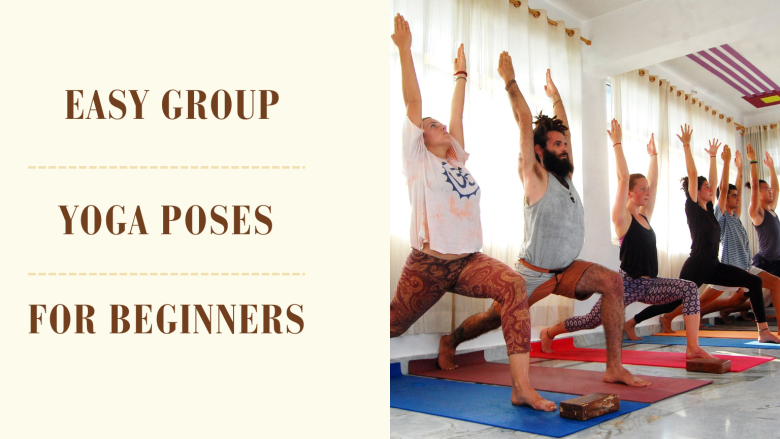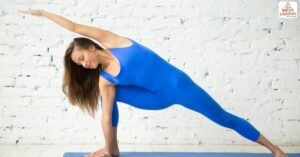Yoga is not a one-person activity; it can also be a wonderful time to be in a group! Doing yoga with your friends, family members, or any community can strengthen the bond and increase the experience. Group yoga practices encourage cooperation, interaction and enjoyment.
This article is going to discuss several group yoga poses for new joiners, their advantages, and guidelines on how to practice them successfully. Easy group yoga poses for beginners are perfect for people who want to start yoga together in a simple way.
Group pose yoga is a type of yoga which are expected to be performed by more than one individual. Such poses facilitate communication and cooperation, giving the participants a chance to provide each other with physical and emotional support. Taking yoga collectively creates a feeling of togetherness and bonding, hence making it more fun. Beginner yoga poses help new learners build strength and balance slowly.
How to Start with Group Yoga Poses for Beginners?
Group yoga can be very clumsy initially, yet through the right guidance and time, you will be moving in perfect sync with your group in no time. The following are some of the suggestions on how you can start practising group yoga:
1. Ease Up With Your Partners
However close you are to your quartet, you should keep in mind that not everybody wants to be touched or even to share intimate places. Therefore, in a group yoga, slow down the physical contact and relax. Get comfortable with the scenario by performing simple yoga warm-ups. The motions in these poses are normally mild and non-intrusive, which can make everybody feel more at ease with one another. Yoga positions for beginners make it easy to understand correct posture and breathing.
2. Start With Basic Moves
To begin with yoga poses for beginners, it is best to keep simple yoga practices. When all feel at ease with the simple ones, you may proceed to more complex poses. You can begin with these four back-to-back chair poses, with basic inversions, or any other pose that does not need a significant amount of physical effort.
3. You Can Do Something Creative
When you and your group feel at ease with each other and the basics of yoga, you can begin to get creative with your group yoga sessions. Attempt to design your own yoga routines or include props that will make the poses more difficult.
Best Group Poses (3+ People)
Some of the best group poses for three or more people are:-
1. Circle Pose
Stand in a circle with your hands. Each time you count or breathe in unison, each person leans slightly away to the opposite of the centre of the circle, and tension arises, and a perfect circle is made up. This needs faith and coordination in order to create a balance. Yoga moves for beginners are gentle and safe for people starting their yoga journey.
2. Group Boat Pose
It is one of the best group yoga poses for beginners. Sit with each other facing each other in a circle (or back-to-back in pairs). Bend the knees, keep the hands with a person beside you and lean backwards to raise the legs and balance the legs in a boat-like manner. The group dynamics contribute to stabilizing all the individuals.
3. Group Tree Pose
Stand in a circle and hold your hands. Lift one leg together as a group and place the sole of that foot on the inner thigh or the calf of the standing leg. This increases equilibrium and a sense of togetherness.
Read Also:- Yoga Retreat in Rishikesh
Best Partner Poses (2 people)
If you and your partner are fitness enthusiasts, then you can opt for group yoga poses for beginners. The best partner poses are the following;
1. Partner Forward Bend
Stand and hold hands facing your partner. This involves one individual bending forward at the hips, and the other leaning back, which creates a mild stretch to both individuals. Basic yoga positions teach the foundation of proper alignment and flexibility. This facilitates communication and support.
2. Back- to- Back Twist
Sit back-to-back with your partner with crossed legs (Easy Pose/Sukhasana). Breathe in to get straight, and exhale. Both partners twist in the same direction, grabbing the knees or shoulders of each other in order to increase the intensity of the stretch. This exposes the spine and the chest.
Benefits of the Group Yoga Poses
The special combination of physical, mental, and social benefits of group yoga poses is mainly achieved on the levels of motivation, better communication and trust. It ensures a stronger sense of community. Also, you can head to our website to experience how yoga can actually make you happier.
Physical Benefits
- Better Stretches and Better Flexibility: Stretches are also more effective and deeper when using the body weight or support of a partner as compared to when that is done alone, without pain and injury.
- Increased Stability and Balance: Numerous partner poses involve supporting each other to stay in balance, which facilitates the general stability and physical awareness of both parties.
- Greater Strength and Alignment: This is because weight support assists a partner in developing muscle strength. Moreover, partners are able to give modifications and physical assistance to make sure that everything is properly aligned and postured, just like having a personal instructor.
- Increased Energy and Stamina: Group session collective energy can be stimulating and may encourage group members to practice more or more intensely.
Mental & Emotional Benefits
- Stress Reduction and Relaxation: When yoga is practised within a group setting, its effects increase the stress-reducing aspect. Coordinated respiration and concentration bring the nervous system to rest and induce deep relaxation.
- Gaining Confidence: It can be effective to do challenging poses along with a group of people to gain confidence, particularly when a beginner feels embarrassed to do it on his or her own.
- Mindfulness and Presence: The group poses nature assumes that individuals remain fully present and mindful of their body as well as that of their partner, which enhances concentration and focus.
- Fun and Playfulness: Group yoga brings about fun and lightness in the practice. Finding the positive things to laugh about without forgetting wobbles and mistakes is a way of making the experience fun.
You May Also Like:- 300 Hour Yoga Teacher Training in Rishikesh
Conclusion
The addition of group yoga poses for beginners brings both physical and socio-emotional advantages to a yoga practice beyond individual practice. In addition to the personal benefits of greater flexibility, balance, and strength, these collaborative poses are essential to the development of core skills in life, including communication, trust and support. Common yoga stretches help relax tight muscles and reduce body stiffness.
The collective act of moving simultaneously with breathing will produce a strong feeling of togetherness and belonging. Such a positive setting not only enhances the stress-relieving and confidence-boosting effects of yoga but also makes the exercise more enjoyable and interesting. Group yoga poses are a different and enriching experience of holistic well-being, whether to deepen the relationship with a partner or create a sense of belonging to a group.




